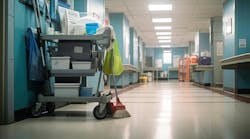Even in this bad economy, green innovations are accelerating. This is good news for children and those with pre-existing health conditions, cleaning personnel and the environment at-large. New green products and services are reducing not only harmful impacts on the environment, but also consumption and cost.
Schools and universities were among the pioneers of the green cleaning movement, but rapid advances make it easy to slip from leader to laggard.
The challenges aren't just from changes to cleaning technologies; institutions are themselves in a state of hyperflux. Budgets are changing, and custodial and maintenance staffing levels are declining as the number of students is increasing. In addition, deferred repairs and maintenance lead to greater challenges in achieving cleaner and more healthful buildings.
Doctor's orders
One step schools and universities can take to be proactive is to conduct an annual "checkup." This checkup can result in a slight modification of a program such as using a new product or two, or a major new course of treatment requiring a wholesale change in the program. Examples include converting more cleaning to the daytime, switching vendors or totally reworking job descriptions, duties and frequencies.
One of the best tools available to conduct such a checkup is the Green Cleaning Award for Schools and Universities. This easy-to-follow program is based on the requirements of the Healthy Schools Campaign's Quick & Easy Guide to Green Cleaning in Schools, the Green Cleaning Network's recommendations on green cleaning products, and the cleaning credits found in the U.S. Green Building Council's LEED for Existing Buildings: Operations & Maintenance Rating System. Collectively, these are the recommended frameworks to an effective green cleaning program and give the institution confidence that the right course is being followed.
Now in its fifth year, the awards program is a terrific tool to identify accomplishments over the past year that can be communicated throughout the institution, as well as to identify opportunities for improvement. The application process has been streamlined to make it easier to apply. Furthermore, consider asking vendors or interns to help put it together, which makes the process even easier.
The application requires only three short descriptions of the program and provides enough information to make it easy to write. The three short descriptions:
-
Describe the history of the program, including when it was started, what it has accomplished and where it is going.
-
Describe the institution's green cleaning program by addressing the following topics:
-
Cleaning procedures and strategies used to reduce general health impacts, which can include strategies for the use of disinfectants, strategies to encourage handwashing, timing of vacuuming or carpet cleaning, and recycling programs to reduce waste.
-
Training being provided for cleaning personnel.
-
Innovative strategies, products or equipment.
-
Evaluation methods and results, such as what is measured and how often, and what has been documented such as air-quality improvements or reduced absenteeism.
-
-
Describe efforts to engage others in the responsibility of green cleaning by addressing the following topics:
-
Policies or processes used to engage others (i.e. teachers, students, visitors and staff) in the responsibility to create a more healthful building.
-
Communications and engagement with the school community, as well as the community at-large.
-
Recognition, including awards or other recognition the green cleaning program has received such as Earth Day fairs, EPA's Tools for Schools award, Green Flag program, etc.
-
Applications are due on Sept. 9 and can be found at asumag.com/green_cleaning_award/. And whether or not the actual application is filed, completing the process provides a terrific checkup for determining progress that has been made and where to head in the upcoming year.
Ashkin is executive director of the Green Cleaning Network, a 501(c)3 not-for-profit educational organization.


